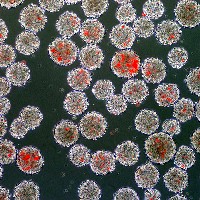Researchers at Sanford-Burnham Medical Research Institute in La Jolla, California have developed a mathematical model that computes the length of time a bone marrow graft made of stem cells will last. The study, led by Christa Muller-Sieburg, appears online this week in the journal Proceedings of the National Academy of Sciences (paid subscription required).
When patients receive a bone marrow transplant, they receive a new population of hematopoietic (blood forming) stem cells. Fresh stem cells are needed when a patient is low on red blood cells, as in anemia, or white blood cells, which can be caused by cancer or even cancer treatments such as irradiation or chemotherapy. However, a bone marrow transplant might not succeed because the transplanted stem cells don’t live long enough or because they proliferate too well, leading to leukemia.
The Sanford-Burnham team’s model predicts how long a stem cell will live and tested those predictions in mice. They found that each stem cell is pre-programmed to self-renew only for a set amount of time that, in mice, ranges from a few months to several years, and the computer model predicts that life span.
The researchers drew blood from transplant recipients and took a few initial measurements of the mature white blood cells generated from the transplant. The team then entered those parameters into a computer program that predicts their life span.
The information from the computer program was then compared to the stem cells’ true life span. Some stem cells lasted five months and others more than three years, but the researchers found the computer program accurately predicted stem cell survival time.
This better understanding of stem cell life spans now allows for better predictions of the the conditions that lead to normal stem cell proliferation. Stem cell self-renewal needs to negotiate a precarious balance: too much self-renewal results in leukemia, while too little leads to bone marrow failure. The findings have implications for other potential stem cell therapies in tissue regeneration, diabetes, and Alzheimer’s disease.
Read more: Lab Tech Company to Release Automated Cell Research System
* * *


 RSS - Posts
RSS - Posts
You must be logged in to post a comment.